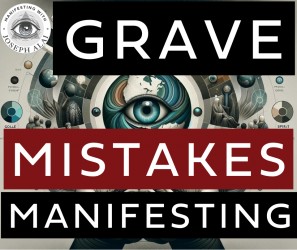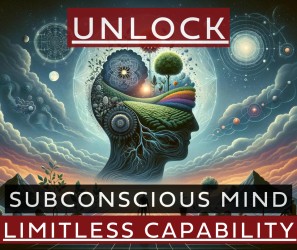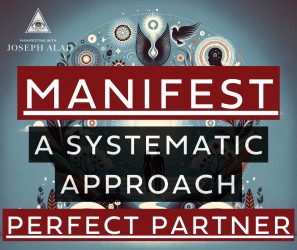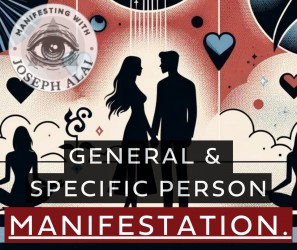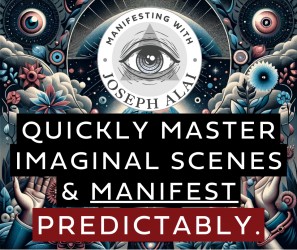Reality is continuously being manifested by our mind. The mind is the cause of impressions on the subconscious mind, which ultimately projects outward. Blending reality is the process of mixing our current reality with our imaginal acts. If we do not clear our consciousness out first, we will mix our imaginal acts with our current state of affairs. If we mix our imaginal acts with our current state of affairs, we will have mixed results. Our new reality will be mixed with our old. This is how we commonly create, without even knowing it. The more powerful we want our mind to affect our reality, the more we should relax and deepen our state of meditation before entering into the imaginal state.
Here is the outline to a video I made on how to overcome the symptoms you may be facing if your manifestations are partial, or if they are not working as well as you would like. The key takeaway is to make sure you plan your imaginal acts beforehand, to relax fully before entering into the imaginal act (don't jump into it), and to imagine until your mind is entirely saturated with the imaginal act -- as if that is your only reality.
Consciousness creates reality.
Consciousness IS reality
nothing exists outside of consciousness
We must embody a new consciousness for us to manifest something
We must crucify ourself to the new conception of ourself, by visualizing ourself from the point of view of the new creation – in order for it to be created.
Abandoning the current state, self-abandonment, is the answer
When you pray, believe you have already received it, and you shall have it.
If you cans’t believe, all things are possible
Belief is a word, commonly misconstrued with hope
Belief, in the scriptural sense, has nothing to do with hoping something is going to happen
It does not mean, “expecting something is going to happen.”
Belief & hope should be used to explain the process of visualizing that you already have it
You can define belief as:
The process of fully aligning your consciousness with the desired state
Failed misinterpretations of visualization and manifestation
Imagine yourself as the person you desire to be, but from the point of view as if you’re watching yourself in third person
Movie screen
“You are”
Imagining it is about to happen
Writing things down as if it has not yet happened
it will happen
Why these are wrong:
Imagine yourself as the person you desire to be, but from the point of view as if you’re watching yourself in third person & movie screen
Wrong because you will manifest the situation to unfold, but in a third person
Unless you believe “I AM he”
Believe YOU have already received it
“You are”
Same explanation as above, and you will replicate that which you are conscious of being
Imagining it is about to happen
You will replicate it about to happen
It will not have happened
It will stop after you imagine it
Writing things down as if it has not yet happened
it will happen
Blending reality
Explanation
We must become acutely aware of only the desired state
“Shut the door”
We must imagine we are already that person, that we already have it
When ye pray, believe…
But how are you imagining?
Visualization & Imaginal Acts
If we define our scene correctly, then we can imagine the scene.
Correct way of imagining:
Shut off external consciousness
close eyes
stop paying attention to sounds
relax our mind
Become present
Focus on breathing
Focus on counting
Calibrate in the scene
Embody the imaginal scene
Populate the scene
Hold it in place
Think from the scene
Imagine yourself there
Add all the elements
Repeat the scene
Repeat it over and over again
Incorrect way of imagining
Common Fallbacks
Not thinking from the scene
Thinking from the point of view of the imaginer
“This feels real”
“I believe this is going to happen”
Contemplating the scene while in the scene
Corrections
Thinking from the scene
Taking the time to let all of your senses and thoughts be in the scene
Letting your thoughts originate from the outline you’ve done beforehand
Thinking from the point of view of the imagined
“I’m so grateful I’m doing xyz”
“Gosh, this vacation is amazing”
“I love being married to xyz”
Contemplating the scene while in the scene
Talking with people about the scene
Feeling things in the scene
Thinking about what I am going to do now that I have…
Fallbacks of blending reality
If we’re thinking half from the point of view of the imaginer, and half from the point of view of the imagined, we will have mixed results
Saying, “This will happen…”, or “I believe this will happen.”, will only guarantee that your manifestation is not going to come to pass.
It replicates the “will happen”, which will create a reality where it has yet to happen
Saying, “I need to add this…”
Takes you out of the present moment
Prevents you from manifesting
You are no longer shutting off the senses
Prevents you from manifesting
You will not impress the subconscious mind
Prevents you from manifesting
May impress your subconscious mind with bits
May impress pieces of your current reality, too
Solution:
Outline your scene beforehand
Memorize the aspects of your scene
Make your scene short and concise
Take time to relax in the present moment
Think of
What would you be thinking if you were there
Looping the scene over and over until you are saturated or fused with the actual scene
